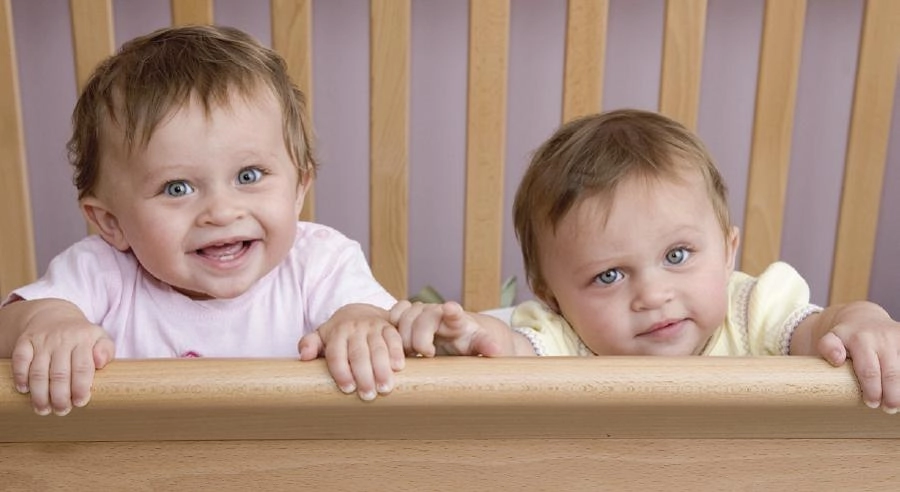By Alice M Vollmar
“I burst into tears when I thought I was holding one baby and then discovered that I was holding the other,” recalled Marlene Flanders. “I said to myself, ‘I’m their mother, and I can’t even tell them apart,’ I sobbed. I wondered how many times I’d had them switched.”
As Marlene and countless other parents of identical multiples know firsthand, telling identical apart can be a challenge for everyone—family, teachers, friends and multiples themselves.
“My gym teacher gets us mixed up, but I wish she’d call me by the right name,” said 10-year-old identical twin Andre Deutschlaender. Andy Nieman, 12, gets annoyed at misidentification, too. “When people at school—my teachers and friends—get us mixed up, I feel like they should know who I am,” he said. Andy and his co-twin, Adam, look alike, although they are fraternal twins.
It’s an accepted fact that not one likes to be called by the wrong name. “A name is a symbol of recognition of our identity, a mark of our sense of ourselves,” explained Susan Erbaugh, Ph.D., chief of psychology at Minneapolis Children’s Medical Center. “Our name stays with us from home to work, from childhood through adulthood. It defines our distinctiveness. Calling a child by the wrong name says, ‘I don’t know or care who you are,’ or ‘We want you to be somebody different.’”
Calling children by the wrong name also “scares kids and makes them man,” Erbaugh added. “As a child’s sense of identity is emerging, it’s upsetting when people say, in essence, that the child doesn’t have a distinct place or identity.”
Establishing a sense of self is doubly challenging for a child with a co-twin who looks just like him. Child development specialists tell parents that it’s important to help each co-twin develop a concept of herself as a distinct individual.
To aid that process, many parents have found that identification strategies can make it easier to correctly identify each twin and to avoid inadvertent mix-ups, even in the first few months of multiples’ lives. Those strategies also address an underlying fear many parents have of accidentally switching their infant twins’ identities permanently.
Marlene Flanders finally put an end to the distressing mix-ups of her twin boys by putting fingernail polish on one of baby Ryan’s toenails. Later, she had Ryan’s hair trimmed to a point in the back and Aaron’s hair squared off. Flanders takes care to call each by the correct name because, as she explained, “They correct other people, but they don’t expect their mother to blow it!”
Parents of identical twins tend to take each co-twin’s autonomy seriously. “Right from the start, I didn’t want to chance a mix-up,” said Robin Gale, whose identical girls are now 6-years-old. “My foremost through has always been that these are two children, two independent individuals. I had a jeweler make gold ID ankle bracelets inscribed with their names, and those bracelets never came off. We just expanded them as Alana and Kayla grew.
When Alana and Kayla were very young, Gale dressed them differently and always knew what outfit each was wearing. “But it was hard for my husband, so he painted fingernail polish on Kayla’s pinky fingernail,” said Gale.
Applying polish to one twin’s toenails or fingernails is an effective strategy, said parents who’ve used it. So is color-coding twin’ clothing.
“We didn’t have any plan when we brought our identical twins home from the hospital,” Karen Jenkins recalled. “So for the first two weeks we painted one of Laura’s toenails. Then we divided up all the clothes and gave Denise blues, purples and greens. Laura got pinks, yellows and reds. Now the girls (age 5) are in preschool, and the teachers really appreciate our color coding.”
Joan King, whose identical twins are now adults had an equally effective system: “I put brown shoes on Brian and black shoes on Bill…It was simple, and everybody knew who was who.”
Amy Keohane still uses a pink and purple color code to help people properly identify her 6-year-old identical twins. Koehane noted that Jennifer and Andrea look more alike now than when they were babies. Then, their heads were shaped differently, one had more hair, and one’s face was a little rounder. Other parents of identical twins have also noted that as their twins grew, they came to resemble each other even more closely than they did as babies.
Parents often distinguish one child from her co-twin by differences in height and weight, face shape, shade of hair, beauty spots or birthmarks, pitch of voice, personality traits and mirror-image characteristics such an opposite handedness and cowlicks. Dawn Stewart recalled that her infant daughter Megan had a darker complexion at birth than her identical co-twin, Lindsey. A small scar above Lindsey’s eyebrow also served as an identity marker.
Penny Morin is grateful for the mirror-image cowlicks (which turn in opposite directions) possessed by her identical 5-year-olds, Jillian and Joleen, and for the differences in their voices. “But from a distance, I have difficulty telling them apart until they speak,” she said.
Personal characteristics such as these can also help other people accurately identify each co-twin. But it’s usually up to parents or the twins themselves to furnish outsiders with appropriate clues. For example, the Morin twins’ aunt was frustrated in her attempts to tell Jillian and Joleen apart until Penny advised her to look at their cowlicks.
Most people can distinguish between identical twins if they take the time to be observant. Andy and Adam Nieman help people identify themselves correctly by choosing different haircuts and clothing. Robin Gale credits her twins’ nursery school teachers with paying close attention each morning to what Alana and Kayla are wearing (they wear similar but different clothing that is not color-coded).
“But when Alana and Kayla started kindergarten,” Gale said, “I asked them if their teacher knew who was who, and they said, ‘No’ so I requested that the teachers determine which child is which each morning by observing differences in their clothing. You can tell them apart when you pay attention, and I absolutely expect teachers to do that,” Gale said.
Many parents of identical twins wish that more people would make a point of noticing differences in clothing or features. “Twins do get tired of being asked, ‘which one are you?’” said Karen Jenkins.
To encourage correct identification, parents can take teachers, relatives and friends aside and suggest ways to tell one twin from the other. For example, a parent might ask to meet with a teacher privately in order to explain the family’s “system”: she could say, for example, “We’ve learned that it’s very important for twins to be identified separately and correctly, so at home we make it a point to never refer to our girls as ‘the twins’ and to always use their names. We would really appreciate it if you would do that, too.”
Parents are advised to use discretion when clarifying distinctions between their co-twins. It’s important not to inadvertently create comparative labels (such as “Jim is the shy one, and John is the outgoing twin”) and comparisons such as height and weight only hold up when twins are viewed together. Color-coded clothing or a child’s individual characteristics, such as her hair style or her left handedness, are more likely to serve as effective indicators and are less likely to reinforce labeling.
Of course, identification strategies aren’t foolproof, and look-alike twins will inevitably be mistaken for one another sometimes. It’s wise to help twins develop a coping strategy for confusion, counseled Erbaugh. “You can let them know that you understand how hard it is to be mistaken for each other,” she said. ‘“Doctors, lawyers and movie stars,’ you might explain, ‘want their names displayed on doors and want top billing. They get upset if their name isn’t displayed. When you are called your co-twin’s name, it’s like you are the star and someone has put the wrong name on the door! That’s hard to take.’”
Parents should help their twins come up with tactful but assertive ways in which they might respond to confused teachers, classmates or even family members. Erbaugh suggested that parents might tell each co-twin, “I know what’s special about you, and the rest of the world will, too, if we help them out a bit.”
A twin can be taught to explain to anyone who makes a mistake that he is John and not Jim, said Erbaugh. He can also learn to furnish people with an identity clue, such as, “one way you can tell us apart is by our hair. I part my hair on the left, and Jim parts his on the right.”
“I explained to Christopher and Andre that people make mistakes because the two of them look so much alike,” said parent Ruth Deutschlaender. “I advise them to just say, ‘I’m Christopher’ or ‘I’m Andre’ when that happens.”
Andre said that’s exactly what he does when the occasion arises. “You can tell us apart by our voices,” he also advised. “We sound different.” Penny Morin’s daughter Joleen the first-born of identical twins, got upset being called by her co-twin’s name. So Morin capitalized on having another set of identical twins in the neighborhood to help Joleen understand why that happened. “I asked her if she sometimes got our neighbor’s twins mixed up. She said, ‘yes,’ so I told her, ‘That’s what happens when people mistake you for Jillian.’”
Ideally, parents and siblings function as role models by identifying and addressing each twin by name. Parents who are conscientious about recognizing and reinforcing each twin’s identity can help twins avoid the resentment voiced by one adult at having been, “a twin, not an individual, always a part of a set rather than a complete person.”
Not all adult twins feel that way, however. Beatrice Hawkinson and Bernice Lindberg, 71, love being twins. About their younger days, Beatrice said, “Our last name was Gustafson,a d we both had the nickname ‘Gustie’ so we didn’t get called the wrong name. Now, when people mistake me for Bernice, I just say, ‘Oh, I’m Beatrice, Bernice’s twin.’”
These adult identical twins feel enriched by their friendship, have never wished not to be twins, and handle identity mix-ups with a touch of humor. “If someone I don’t know smiles at me in the grocery store, I smile back because otherwise, they’ll go and ask Beatrice why she was so stuck-up the other day,” chuckled Bernice.
A sense of humor helps twins live with the inevitable, occasional mix-up. And yes, even moms and dads sometimes err and call one of their twins the wrong name. Then, it’s reassuring to remember that even parents of singletons call their offspring the wrong name from time to time—and they don’t have a good excuse!
Alice M Vollmar of Minneapolis, Minnesota, is a freelance writer and the mother of six children, including boy/girl twins.






There is 1 comment
The twins photo in the article Who’s who? ‘Fool proof ways of telling them apart’ are now nearly 6 years old and just started school. I new article could be ‘to seperate in Prep (first year of school) or not.
Would love to share a pic and my experience.